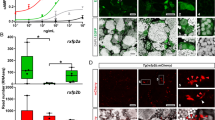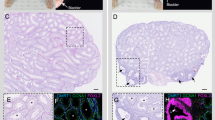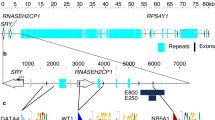Abstract
In mice, gonads are formed shortly before embryonic day 10.5 by the thickening of the mesonephros and consist of somatic cells and migratory primordial germ cells1. The male sex-determining process is set in motion by the sex-determining region of the Y chromosome (Sry), which triggers differentiation of the Sertoli cell lineage. In turn, Sertoli cells function as organizing centres and direct differentiation of the testis. In the absence of Sry expression, neither XX nor XY gonads develop testes2, and alterations in Sry expression are often associated with abnormal sexual differentiation3,4,5,6,7,8. The molecular signalling mechanisms by which Sry specifies the male pathway and models the undifferentiated gonad are unknown. Here we show that the insulin receptor tyrosine kinase family, comprising Ir, Igf1r and Irr, is required for the appearance of male gonads and thus for male sexual differentiation. XY mice that are mutant for all three receptors develop ovaries and show a completely female phenotype. Reduced expression of both Sry and the early testis-specific marker Sox9 indicates that the insulin signalling pathway is required for male sex determination.
This is a preview of subscription content, access via your institution
Access options
Subscribe to this journal
Receive 51 print issues and online access
$199.00 per year
only $3.90 per issue
Buy this article
- Purchase on Springer Link
- Instant access to full article PDF
Prices may be subject to local taxes which are calculated during checkout




Similar content being viewed by others
References
Capel, B. The battle of the sexes. Mech. Dev. 92, 89–103 (2000)
Capel, B. et al. Deletion of Y chromosome sequences located outside the testis determining region can cause XY female sex reversal. Nature Genet. 5, 301–307 (1993)
Lee, C. H. & Taketo, T. Normal onset, but prolonged expression, of Sry gene in the B6.YDOM sex-reversed mouse gonad. Dev. Biol. 165, 442–452 (1994)
Washburn, L. L., Albrecht, K. H. & Eicher, E. M. C57BL/6J-T-associated sex reversal in mice is caused by reduced expression of a Mus domesticus Sry allele. Genetics 158, 1675–1681 (2001)
Tevosian, S. G. et al. Gonadal differentiation, sex determination and normal Sry expression in mice require direct interaction between transcription partners GATA4 and FOG2. Development 129, 4627–4634 (2002)
Nagamine, C. M., Morohashi, K., Carlisle, C. & Chang, D. K. Sex reversal caused by Mus musculus domesticus Y chromosomes linked to variant expression of the testis-determining gene. Sry. Dev. Biol. 216, 182–194 (1999)
Hammes, A. et al. Two splice variants of the Wilms' tumor 1 gene have distinct functions during sex determination and nephron formation. Cell 106, 319–329 (2001)
Albrecht, K. H., Young, M., Washburn, L. L. & Eicher, E. M. Sry expression level and protein isoform differences play a role in abnormal testis development in C57BL/6J mice carrying certain Sry alleles. Genetics 164, 277–288 (2003)
Accili, D. et al. Early neonatal death in mice homozygous for a null allele of the insulin receptor gene. Nature Genet. 12, 106–109 (1996)
Joshi, R. L. et al. Targeted disruption of the insulin receptor gene in the mouse results in neonatal lethality. EMBO J. 15, 1542–1547 (1996)
Liu, J. P., Baker, J., Perkins, A. S., Robertson, E. J. & Efstratiadis, A. Mice carrying null mutations of the genes encoding insulin-like growth factor I (Igf-1) and type 1 IGF receptor (Igf1r). Cell 75, 59–72 (1993)
Louvi, A., Accili, D. & Efstratiadis, A. Growth-promoting interaction of IGF-II with the insulin receptor during mouse embryonic development. Dev. Biol. 189, 33–48 (1997)
Kitamura, T. et al. Preserved pancreatic β-cell development and function in mice lacking the insulin receptor-related receptor. Mol. Cell. Biol. 21, 5624–5630 (2001)
Schlessinger, J. Cell signaling by receptor tyrosine kinases. Cell 103, 211–225 (2000)
Fernandez, A. M. et al. Functional inactivation of the IGF-I and insulin receptors in skeletal muscle causes type 2 diabetes. Genes Dev. 15, 1926–1934 (2001)
Nef, S. & Parada, L. F. Cryptorchidism in mice mutant for Insl3. Nature Genet. 22, 295–299 (1999)
Swain, A. & Lovell-Badge, R. Mammalian sex determination: a molecular drama. Genes Dev. 13, 755–767 (1999)
Vainio, S., Heikkila, M., Kispert, A., Chin, N. & McMahon, A. P. Female development in mammals is regulated by Wnt-4 signalling. Nature 397, 405–409 (1999)
Soyal, S. M., Amleh, A. & Dean, J. FIGα, a germ cell-specific transcription factor required for ovarian follicle formation. Development 127, 4645–4654 (2000)
Parr, B. A. & McMahon, A. P. Sexually dimorphic development of the mammalian reproductive tract requires Wnt-7a. Nature 395, 707–710 (1998)
Clarkson, M. J. & Harley, V. R. Sex with two SOX on: SRY and SOX9 in testis development. Trends Endocrinol. Metab. 13, 106–111 (2002)
Schmahl, J. & Capel, B. Cell proliferation is necessary for the determination of male fate in the gonad. Dev. Biol. 258, 264–276 (2003)
Burgoyne, P. & Palmer, S. in Gonadal Development and Function (ed. Hiller, S. G.) 17–29 (Raven, New York, 1993)
Colvin, J. S., Green, R. P., Schmahl, J., Capel, B. & Ornitz, D. M. Male-to-female sex reversal in mice lacking fibroblast growth factor 9. Cell 104, 875–889 (2001)
Scherer, G. Introduction: vertebrate sex determination and gonadal differentiation. Cell. Mol. Life Sci. 55, 991–909 (1999)
Jeske, Y. W., Bowles, J., Greenfield, A. & Koopman, P. Expression of a linear Sry transcript in the mouse genital ridge. Nature Genet. 10, 480–482 (1995)
Kernie, S. G., Erwin, T. M. & Parada, L. F. Brain remodeling due to neuronal and astrocytic proliferation after controlled cortical injury in mice. J. Neurosci Res. 66, 317–326 (2001)
Acknowledgements
We thank R. Menon, Y.-J. Li, S. McKinnon, Z. Jorai, J. Kargel,T. Shipman, J.-L. Pitetti and the genomic platform of the Frontiers in Genetics at the National Center of Competence in Research for technical assistance; all members of the Parada laboratory for discussions; A. McMahon, R. Behringer, K. Parker, R. Lovell-Badge and J. Dean for probes; and J. Wilson, K. Parker, J. Graff, J. Goldstein and G. Karsenty for critically reading the manuscript. This work was funded by an Excellence in Education Endowment to L.F.P.
Author information
Authors and Affiliations
Corresponding author
Ethics declarations
Competing interests
The authors declare that they have no competing financial interests.
Supplementary information
Rights and permissions
About this article
Cite this article
Nef, S., Verma-Kurvari, S., Merenmies, J. et al. Testis determination requires insulin receptor family function in mice. Nature 426, 291–295 (2003). https://doi.org/10.1038/nature02059
Received:
Accepted:
Issue Date:
DOI: https://doi.org/10.1038/nature02059
This article is cited by
-
The transcriptional regulator CBX2 and ovarian function: A whole genome and whole transcriptome approach
Scientific Reports (2019)
-
Potential contributions of heat shock proteins and related genes in sexual differentiation in yellow catfish (Pelteobagrus fulvidraco)
Fish Physiology and Biochemistry (2017)
-
Differential organ phenotypes after postnatal Igf1r gene conditional deletion induced by tamoxifen in UBC-CreERT2; Igf1r fl/fl double transgenic mice
Transgenic Research (2015)
-
Generation of fertile and fecund F0 XY female mice from XY ES cells
Transgenic Research (2015)
-
The emerging role of insulin-like growth factors in testis development and function
Basic and Clinical Andrology (2014)
Comments
By submitting a comment you agree to abide by our Terms and Community Guidelines. If you find something abusive or that does not comply with our terms or guidelines please flag it as inappropriate.



